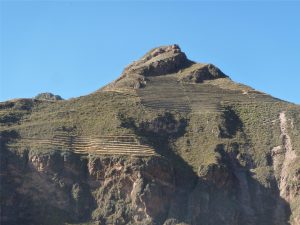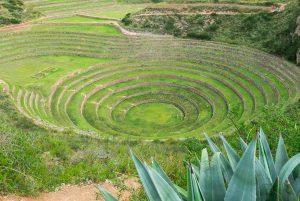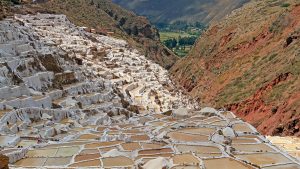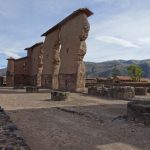Raqchi, known as the Temple of Wiracocha, is a living testament to the spirituality, organization, and grandeur of the Inca Empire. Visitors discover that it is not just a temple, but a monumental complex where religion, administration, and daily life intertwined in perfect harmony.

The Temple of Wiracocha: A Giant in the Andes
The heart of the complex is the Temple of Wiracocha, a colossal structure dedicated to the creator god of the universe.
-Impressive dimensions: the temple measures approximately 92 meters long by 25 meters wide, with walls reaching up to 14 meters high.
-A unique central wall: The most striking feature is the large wall that divides the temple into two naves. Built with a stone base and an adobe elevation, it is one of the tallest surviving walls of Inca architecture.
-Monumental columns: Circular bases supporting stone and wood columns are distributed around the wall. These would have supported a gigantic roof, possibly the largest built in the Tahuantinsuyu.
The temple’s design reflects the importance the Incas placed on Wiracocha, not only as a creator god, but also as a protector of cosmic and social order.
A complex beyond the religious
Although the temple is the centerpiece, Raqchi was much more than a ceremonial space.
Qolqas or storage rooms: More than 150 circular warehouses have been preserved, arranged in orderly rows. They housed grains, tubers, and food for both the population and the army.
-Living quarters: Living quarters for priests, officials, and workers, which show how the site also functioned as an administrative center.
-Fountains and canals: remains of hydraulic systems used for purification rituals, where water symbolized life and fertility.
-Perimeter walls: The complex was protected by high stone walls, demonstrating its strategic and religious significance.
-Raqchi was undoubtedly a multifunctional city, a center where religion, economy, and political control combined.
Raqchi and the Qhapaq Ñan
The complex is closely linked to the Qhapaq Ñan, the network of roads that united the entire Tahuantinsuyu. Raqchi was a key point on the Cusco–Collao route, connecting the Inca capital with the highland regions.
Thanks to this strategic location, food was stored here and llama caravans were organized to transport goods. Furthermore, travelers could find rest and supplies along their journey.
The spirituality of the place
Visiting Raqchi is not just about exploring ruins; it is about experiencing the energy of a space that the Incas considered sacred. The wind passing through the walls, the immensity of the temple, and the view of the nearby mountains make the experience almost mystical.
Many visitors say the site conveys a special power, as if still inhabited by the memory of the god Wiracocha and the people who worshipped him.


The Village of Raqchi: Living Tradition
Next to the complex is the current village of Raqchi, inhabited by Quechua families who keep their customs alive.
Visitors can tour pottery, weaving, and carving workshops, made with techniques inherited from past generations. Visitors can also sample typical dishes such as fried trout, chuñoca, or the traditional huatia (potato cooked underground).
This contact with the community enriches the experience, as it shows that Raqchi is not only the past, but also the present.

Practical tips for your visit
📍 Location
San Pedro District, Canchis Province, Cusco.
About 117 km from the city of Cusco, on the route to Puno.
🚍 How to get there
By bus or colectivo from Cusco to Sicuani or Puno.
As part of a tour to the South Valley, which usually includes Andahuaylillas, Pikillacta, and Raqchi.
🎟️ Entrance fee
Included in the Cusco Tourist Ticket (Circuit 2 – South Valley).
You can also pay directly at the entrance, although it is best to purchase the official ticket.
🕒 Visit time
Allow at least 1 to 1.5 hours to tour the temple, the storage rooms, and the residential areas.
If you visit the town and its workshops, allow half a day total.
☀️ Recommendations
-Wear a hat, sunscreen, and water, as the sun can be intense.
-Wear comfortable, lightweight clothing, including a light jacket in case it gets cool.
-Don’t forget cash, as there are no ATMs or electronic payments in the area.
Raqchi: A Giant That Still Breathes
The Raqchi Archaeological Center is much more than ancient stones: it is a testament to how the Incas organized their society, how they worshipped their gods, and how they connected their empire through roads and warehouses.
Its monumental temple, dedicated to Wiracocha, it remains a powerful echo of the past, inviting travelers from around the world to discover a profound and lesser-known, but equally magnificent, Cusco.
Visiting Raqchi is to face the grandeur of the Incas, experience the spirituality of the Andes, and take home a memory that will remain etched forever.









Leave A Reply